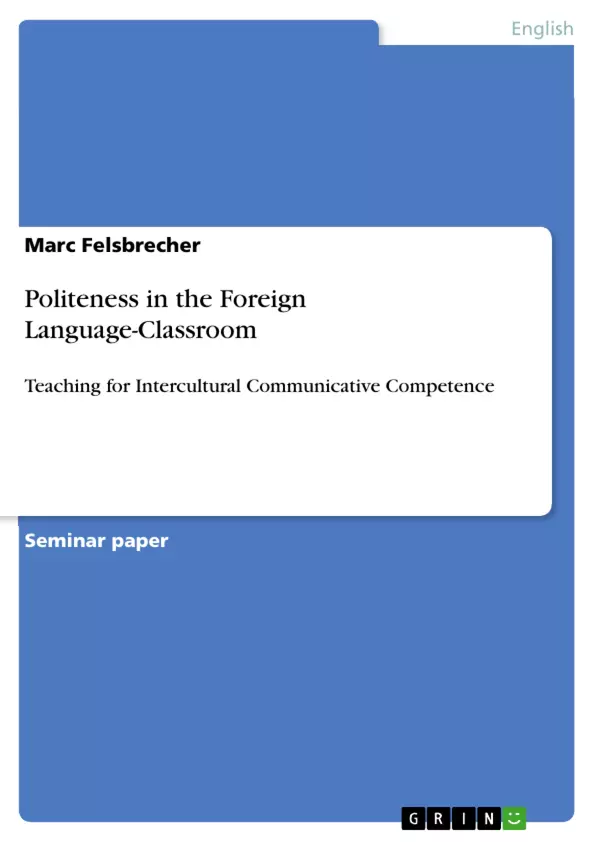It is the aim of this paper to analyze how politeness currently is – and how politeness potentially could be – taught in foreign language classrooms. The focus will be on how foreign language students are – or could be – instructed to perform speech acts that usually require forms of politeness. Teaching politeness will not be reduced to the introduction of cultural stereotypes and basic rules of behavior in language teaching, it will rather be understood as all forms of the pragmatic knowledge required to develop true intercultural communicative competence in the foreign language student.
It is argued that currently teaching pragmatics only plays a minor role in foreign language teaching, but that this knowledge is crucial to build up intercultural communicative competence as it is demanded by the CEFR and foreign language curricula. To prove this thesis, current textbooks for teaching English as a foreign language will be examined for teaching activities that include aspects of foreign language pragmatics or politeness. In a subsequent chapter, the didactics and methodology of instructional pragmatics will be discussed on the basis of literature from the field of pedagogy.
Inhaltsverzeichnis (Table of Contents)
- Introduction: Intercultural Communicative Competence, Teaching Pragmatics and the Curriculum
- Pragmatics in the Foreign Language Classroom - A Status Analysis
- How can Politeness be Taught? – The Methodology of Instructional Pragmatics
Zielsetzung und Themenschwerpunkte (Objectives and Key Themes)
This research paper examines how politeness is currently taught in foreign language classrooms and explores potential approaches for incorporating politeness instruction into language learning. It focuses on teaching foreign language students how to perform speech acts requiring politeness, going beyond simple cultural stereotypes and basic behavioral rules. The paper argues that teaching pragmatics, especially politeness, plays a crucial role in developing true intercultural communicative competence, as advocated by the Common European Framework of Reference for Languages (CEFR) and foreign language curricula.
- The importance of teaching pragmatics for intercultural communicative competence
- The current state of pragmatics instruction in foreign language classrooms
- Methodology of instructional pragmatics and its application to politeness teaching
- The role of politeness in foreign language curricula
- The relationship between communicative competence and intercultural competence
Zusammenfassung der Kapitel (Chapter Summaries)
- Introduction: Intercultural Communicative Competence, Teaching Pragmatics and the Curriculum: This chapter explores the concept of intercultural communicative competence and its significance in foreign language teaching. It examines the inclusion of pragmatics, particularly politeness, in current foreign language curricula and highlights the need for a deeper understanding of politeness beyond superficial "rules of thumb."
- Pragmatics in the Foreign Language Classroom - A Status Analysis: This chapter analyzes the current state of pragmatics teaching in foreign language classrooms. It investigates the extent to which politeness is addressed in textbooks and teaching practices, providing insights into the current level of integration of pragmatics in language instruction.
- How can Politeness be Taught? – The Methodology of Instructional Pragmatics: This chapter delves into the methodology of instructional pragmatics, exploring effective approaches for teaching politeness. It examines relevant pedagogical literature and presents strategies for incorporating politeness into foreign language lessons.
Schlüsselwörter (Keywords)
Key concepts and terms explored in this research paper include: intercultural communicative competence, teaching pragmatics, politeness, instructional pragmatics, foreign language curriculum, speech acts, sociolinguistic competence, and the Common European Framework of Reference for Languages (CEFR).
- Quote paper
- Marc Felsbrecher (Author), 2017, Politeness in the Foreign Language-Classroom, Munich, GRIN Verlag, https://www.grin.com/document/358321



